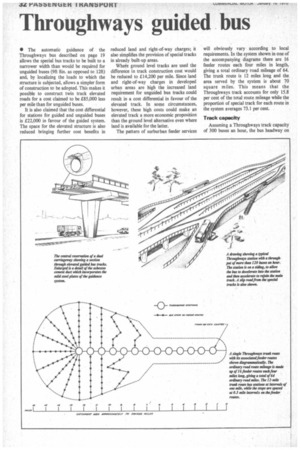Throughways guided bus
Page 34

If you've noticed an error in this article please click here to report it so we can fix it.
• The automatic guidance of the Throughways bus described on page 19 allows the special bus tracks to be built to a narrower width than would be required for unguided buses (9ft 8in. as opposed to 12ft) and, by localizing the loads to which the structure is subjected, allows a simpler form of construction to be adopted. This makes it possible to construct twin track elevated roads for a cost claimed to be £85,000 less per mile than for unguided buses.
It is also claimed that the cost differential for stations for guided and unguided buses is £22,000 in favour of the guided system. The space for the elevated structure is also reduced bringing further cost benefits in reduced land and right-of-way charges; it also simplifies the provision of special tracks in already built-up areas.
Wheie ground level tracks are used the difference in track construction cost would be reduced to £14,200 per mile. Since land and right-of-way charges in developed urban areas are high the increased land requirement for unguided bus tracks could result in a cost differential in favour of the elevated track. In some circumstances, however, these high costs could make an elevated track a more economic proposition than the ground level alternative even where land is available for the latter.
The pattern of surburban feeder services will obviously vary according to local requirements. In the system shown in one of the accompanying diagrams there are 16 feeder routes each four miles in length, giving a total ordinary road mileage of 64. The trunk route is 12 miles long and the area served by the system is about 70 square miles. This means that the Throughways track accounts for only 15.8 per cent of the total route mileage while the proportion of special track for each route in the system averages 73.1 per cent.
Track capacity
Assuming a Throughways track capacity of 300 buses an hour, the bus headway on
































































































